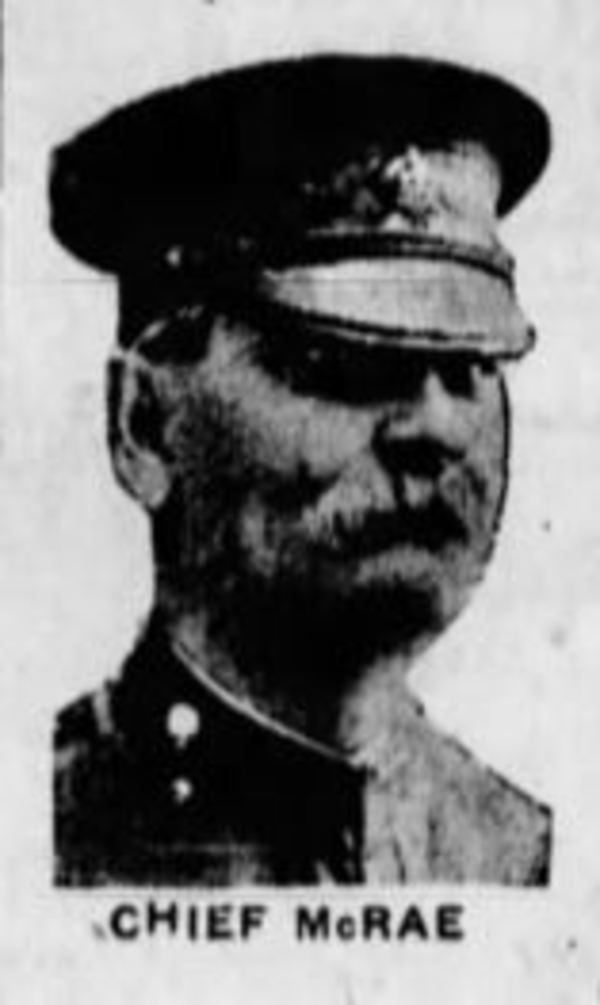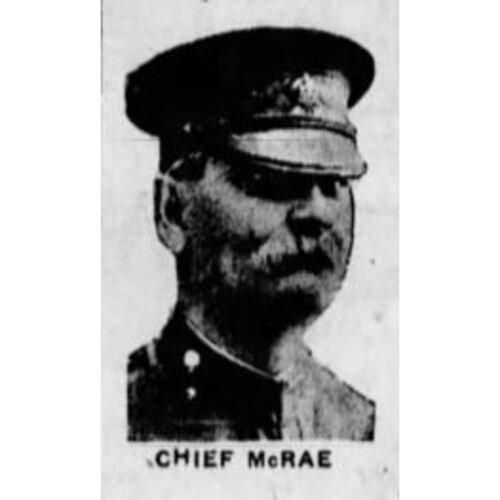
Source: Link
McRAE, JOHN C., policeman and chief of police; b. 4 March 1859 in Carleton County, Upper Canada, son of Alexander McRae, a farmer, and Ann Conley; m. ——— Frizzell, and they had two sons and two daughters who survived him; d. 19 July 1921 in Winnipeg.
A Scots Presbyterian, John McRae (the date and reason he assumed the middle initial are not known) was 20 when he left Ontario to homestead in the small southwestern Manitoba community of Minnedosa; he remained there only a few months before moving to Winnipeg. He joined the city’s police force in 1881. Five years later he was promoted sergeant and he became Winnipeg’s third chief constable in 1887.
McRae’s rapid rise and his fame as a police officer were due in large measure to his apprehension of a number of high-profile criminals. In 1885 he had pursued Bulldog Kelly all the way into the United States before arresting the alleged murderer and returning him to Manitoba. Two years later, while attempting to detain one of the province’s most notorious cattle rustlers, Joseph Fant, he was shot in the groin. Both the chase and the lengthy trial that followed the fugitive’s arrest solidified his already notable reputation for bravery. In 1889 he gained even further recognition when he single-handedly captured Martin Burke, one of the men responsible for the murder of Chicago doctor Patrick Henry Cronin, a homicide immortalized in Henry M. Hunt’s Crime of the century. An imposing figure who did not make friends readily, McRae was nonetheless well regarded by the police force and the general public.
Despite a well-earned reputation for integrity, McRae received considerable criticism for his role in re-establishing a segregated red-light district in Winnipeg in 1909. A campaign in late 1903 led by the Reverend Frederic Beal Du Val had succeeded in abolishing the city’s policy of tolerating prostitutes in a segregated area. In 1904 the police had raided and closed the district. Prostitution continued to increase, however, and McRae did not have enough men to deal with it, especially since it spread throughout the city. In 1909 the Winnipeg Police Commission decided to leave the regulation of brothels to McRae’s discretion, tacitly accepting that he would reintroduce segregation in an attempt to control the problem. The following year, in a series of articles in Toronto newspapers, a prominent Presbyterian minister and national secretary of the Moral and Social Reform Council of Canada, the Reverend John George Shearer, accused Winnipeg of being the vice capital of the nation and implied that its police officials were guilty of graft. A commission established late in 1910 to investigate the charges exonerated McRae from any wrongdoing, but also found that the more than 50 houses of prostitution in the city existed because their presence was sanctioned by the police chief.
In 1911 McRae resigned as chief. With an annual pension of $2,485 the Winnipeg Telegram regarded him as being “comparatively a poor man.” Largely uneducated, McRae had worked hard to improve both himself and the police force during his 24-year tenure as chief, the longest in Winnipeg’s history. The force had expanded significantly during that period, from 13 men when he took office to over 108 men when he retired. He had seen to the construction of a new headquarters (1908) and two sub-stations (1911) and is credited with the introduction of a pension system, a variety of new investigative techniques, a motorcycle patrol, and North America’s first police signal system (with 158 call boxes).
Two years after his retirement, McRae became one of the first recipients in Canada of the King’s Police Medal, awarded for exceptional courage, skill, and distinguished service. He came out of retirement briefly in 1915 to act as a special commissioner for the provincial police during the investigation and prosecutions associated with the scandal over the construction of the Manitoba legislative buildings involving the premier, Sir Rodmond Palen Roblin*, the minister of education, George Robson Coldwell, and others. He was 62 and in poor health when he died at his Winnipeg home in 1921. He left an estate of just under $64,000.
John C. McRae published an article entitled “I remember” in the Winnipeg Telegram, 25 Dec. 1911.
AM, ATG 25, file 13840; AMLJH, P 1359, file A0044. LAC, RG 6, D1, 359, file 114-2-k1-1, pt. 2. Manitoba Free Press, 24 Feb., 18 March 1886; 10–11 Jan., 1 Feb., 12 Nov. 1887; 17 June 1889; 10 June 1911; 2 Jan. 1913; 19–20, 22 July 1921. Winnipeg Telegram, 10 June 1911, 20 Sept. 1915. Winnipeg Tribune, 19 July 1921. A. F. J. Artibise, Winnipeg: a social history of urban growth, 1874–1914 (Montreal and London, 1975). Canadian annual rev., 1915. B. E. Chaffey, “Regina vs. Fant, a tale of fifty years ago,” Manitoba Bar News (Winnipeg), 9 (1936–37): 327–29, 331–32. Joy Cooper, “Red lights of Winnipeg,” Man., Hist. and Scientific Soc., Papers (Winnipeg), 3rd ser., no.27 (1970–71): 61–74. Gateway city: documents on the city of Winnipeg, 1873–1913, ed. and intro. A. F. J. Artibise (Winnipeg, 1979), 207–23. H. M. Hunt, The crime of the century, or, the assassination of Dr. Patrick Henry Cronin: a complete and authentic history of the greatest of modern conspiracies ([Chicago, 1889]). Robert Hutchison, A century of service: a history of the Winnipeg police force, 1874–1974 (Winnipeg, 1974). The Queen v. Cloutier (1898), Manitoba Reports (Winnipeg), 12 (1897–99): 183–89. H. A. Robson, Judge Robson on segregation or toleration of vice . . . the report of the Social Vice Commission, Winnipeg, January 11th, 1911 (Toronto, [1911?]). Jack Templeman, From force to service: a pictorial history of the Winnipeg Police Department: 125th anniversary (Winnipeg, 1998).
Cite This Article
Dale Brawn, “McRAE, JOHN C.,” in Dictionary of Canadian Biography, vol. 15, University of Toronto/Université Laval, 2003–, accessed December 20, 2025, https://www.biographi.ca/en/bio/mcrae_john_c_15E.html.
The citation above shows the format for footnotes and endnotes according to the Chicago manual of style (16th edition). Information to be used in other citation formats:
| Permalink: | https://www.biographi.ca/en/bio/mcrae_john_c_15E.html |
| Author of Article: | Dale Brawn |
| Title of Article: | McRAE, JOHN C. |
| Publication Name: | Dictionary of Canadian Biography, vol. 15 |
| Publisher: | University of Toronto/Université Laval |
| Year of publication: | 2005 |
| Year of revision: | 2005 |
| Access Date: | December 20, 2025 |



